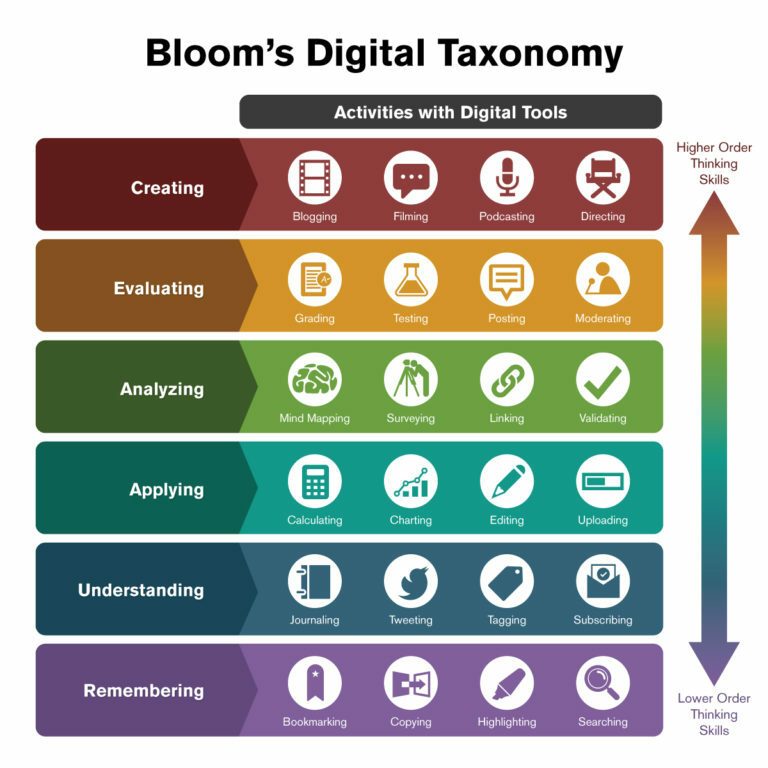e-Learning Ecologies MOOC’s Updates
Reflective Thinking & Digital Collaboration
Digital collaboration brings together groups of students into learning networks. While technology can increase highly collaborative and creative processes, a student’s ability to think about their learning and then articulate their thoughts using e-learning tools must first be considered. Before teachers can expect students to successfully collaborate with peers in digital environments they need to identify the skills that students need to master to support the virtual skill (Scalise, 2018). The metacognitive and reflective skills of students are determining factors in the success of collaborative learning in digital environments. Watch the following video to learn about metacognition:
An exploratory study conducted by Gauthier and Karsenti (2018) of student online collaborative writing found that collaborative technology with metacognitive prompts from teachers strengthened students’ use of metacognitive strategies and feelings of competence. Study findings also showed that the quality of student work increased as did their motivation.
Metacognitive or reflective prompts help students think about thinking and learning. According to Jensen and Snider (2013), “reflection is a powerful tool” (p. 127) that positively impacts learning. The hierarchical ordering of cognitive skills defined in Bloom’s Taxonomy can help teachers teach and students learn about thinking (Pappas, 2019). Using the following prompts, students can assess their learning and in-turn be reflective participants in collaborative learning.
Bloom’s Digital Taxonomy emerged as educators have thought of transformative ways to connect digital tools and reflective thinking. Bloom’s Digital Taxonomy informs instructors of “how to use technology and digital tools to facilitate student learning experiences and outcomes” (Sneed, 2019, para. 3).
The evolution of technology-mediated pedagogy can perpetuate traditional frameworks of education unless teachers and students employ reflective feedback loops as they track and assess all steps in the learning process, including during collaborative learning. Feedback capacity increases with digital tools such as those presented in Bloom’s Digital Taxonomy. However, the quality of feedback improves when collaborators use metacognitive prompts and reflective thinking when self-assessing and peer-assessing.
References
Gauthier, M.C. & Karsenti, T. (2018). An exploratory study of student online collaborative writing with teacher metacognitive prompts. In T. Bastiaens, J. Van Braak, M. Brown, L. Cantoni, M. Castro, R. Christensen, G. Davidson-Shivers, K. DePryck, M. Ebner, M. Fominykh, C. Fulford, S. Hatzipanagos, G. Knezek, K. Kreijns, G. Marks, E. Sointu, E. Korsgaard Sorensen, J. Viteli, J. Voogt, P. Weber, E. Weippl & O. Zawacki-Richter (Eds.), Proceedings of EdMedia: World Conference on Educational Media and Technology (pp. 29-36). Amsterdam, Netherlands: Association for the Advancement of Computing in Education (AACE). Retrieved May 23, 2020 from https://www.learntechlib.org/primary/p/184174/.
Jensen, E. & Snider, C. (2013). Turnaround tools for the teenage brain. San Francisco, CA: Jossey-Bass
Pappas, P. (2019). 10 metacognitive prompts to help students reflect on their learning. Retrieved from https://teachthought.com/learning/metacognitive-prompts-to-help-students-reflect-on-their-learning/
Scalise K. (2018) Next wave for integration of educational technology into the classroom: Collaborative technology integration planning practices. In: Care E., Griffin P., Wilson M. (eds) Assessment and Teaching of 21st Century Skills. Educational Assessment in an Information Age. Springer, Cham
Sneed, O. (2016). Integrating technology with Bloom’s taxonomy. Retrieved from https://teachonline.asu.edu/2016/05/integrating-technology-blooms-taxonomy/



